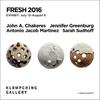The Jazz Age: American Style in the 1920s
- CLEVELAND, Ohio
- /
- September 27, 2017
The Jazz Age: American Style in the 1920s is the first major museum exhibition to focus on American taste in art and design during the 1920s and early 1930s. Through a rich array of over 300 extraordinary works in jewelry, fashion, automobiles, paintings and decorative arts, featuring the events and people that punctuated the era, the exhibition explores the impact of European influences, American lifestyle, artistic movements and innovation during this exciting period. The Jazz Age: American Style in the 1920s is co-organized by the Cleveland Museum of Art and the Cooper Hewitt, Smithsonian Design Museum, and is on view in the Kelvin and Eleanor Smith Foundation Hall from September 30, 2017 through January 14, 2018.
“The Jazz Age: American Style in the 1920s is a blockbuster show—gorgeous, bountiful, exhilarating,” said William Griswold, director of the Cleveland Museum of Art. “The exhibition explores the creative impulses that shaped American taste in that dynamic era, as well as new ideas that challenged the status quo and a desire for change in art and design. We are excited to give our visitors an inside look at this glorious age of innovation and artistic expression.”
“Nowhere else can be seen under one roof such an extraordinary group of design masterworks, which formed the essence of American style in the first half of the 20th century, than in this exhibition,” said Stephen Harrison, curator of decorative art and design. “Some of these rare pieces represent recent discoveries. Others are owned privately and have not been seen publicly since they were made in the 1920s. These works pushed the boundaries of art and design in an age when people were hungry for change.”
After the First World War, with the postwar map of Europe redrawn and social mores redefined, design influences merged—especially in Paris, Vienna and across the United States. New fortunes, primarily American, fueled self-indulgence and consumption, prompting design featuring vibrant colors, sumptuous materials and a unique sense of freedom. The United States became the leading marketplace for innovative architecture, interior design, decorative art, fashion and music, with industrial design moving into the domestic sphere.
Craftsmanship and experimentation flowed back and forth across the Atlantic, with an influx of European émigré designers coming to America and American creative talent traveling and studying abroad. Organized in six sections, The Jazz Age: American Style in the 1920s explores objects affected by the purchasing power of new fortunes and new tastes, and reveals a decade marked by sharp contrasts as new ideas began to challenge traditional revival styles.
The exhibition opens with A New Look for Familiar Forms, providing updated, modern interpretations of older styles of decoration. Émile-Jacques Ruhlmann, Edgar Brandt, Armand-Albert Rateau, Jean Dunand and Raoul Dufy were among those who produced extraordinary objects using lavish craftsmanship, exotic materials and high technical skill, often invoking earlier French styles but with pared-down form. This trend influenced American manufacturers, especially in furniture, while silver and jewelry design forged an important connection between traditional techniques and new influences.
Next, A Smaller World explores transatlantic connections that helped blend influences and cultures. Trained designers arriving from Vienna, Berlin and Eastern Europe brought new aesthetics to the United States, especially an interest in industrial design and the American skyscraper.
The Persistence of Traditional “Good Taste” features works that show how Americans equated “good taste” and social success with older European styles of design, a trend showcased through some of the finest colonial revival decorative arts produced in America. Antiquing became a national pastime and, along with the purchase of historic reproductions, formed the cornerstone of traditional American decor.
Bending the Rules showcases a new ideal for the young modern woman, dictating more revealing fashions and calling for colorful jewelry in exotic forms as well as accessories for cosmetics and cigarette smoking that lent additional glamour and adventure to liberated lifestyles. Fashionable people “stepped out” to nightclubs on both sides of the Atlantic to hear jazz music, which transformed traditional concert venues into dance halls and gave the era a new pulse.
Abstraction and Reinvention explores the simple shapes and minimalistic decoration that defined modernism in the first half of the 1920s, as well as the use of bold geometric shapes that took hold in the latter half of the decade. These abstracted and often fragmented shapes were influenced by fine art movements such as Cubism, but they also emanated from architectural sources as diverse as the stepped shapes of ancient Mayan temples, the setback profiles of skyscrapers and the open-plan arrangements of interior spaces, especially those of Frank Lloyd Wright.
The final gallery, Toward a Machine Age, highlights the technological and stylistic innovations of the 1920s that became widespread in America by the early 1930s. Modern design of pure form and minimal decoration fit the era’s innovations in new technology and industrial materials, such as tubular steel, rubber, plastics and chrome. Revolutionary advancements in transportation were accompanied by new aerodynamic designs that emphasized speed. The popularity of this aesthetic informed the look of both luxury goods and everyday objects, heralding a new age of machines.
More than three dozen objects from The Jazz Age: American Style in the 1920s will be featured on the Reveal and Zoom Wall in ARTLENS Studio and in a curated view previewing the exhibition on the ARTLENS Wall. Works from the CMA’s permanent collection featured in the exhibition can also be found in the ARTLENS App. The app is free to download to iPads or iPhones running iOS9 or higher, or an Android device (4.4+), from the iTunes App Store or Google Play.
Tickets for The Jazz Age: American Style in the 1920s include an audio tour produced by Acoustiguide that offers additional context about this dynamic era of innovation, burgeoning modernity and cultural exchange between America and Europe, including an introduction by William Griswold and extended interpretation for 21 artworks in the exhibition.
Exhibition Catalogue
Lavishly illustrated with hundreds of full-color illustrations and featuring essays by Stephen Harrison, curator of decorative art and design at the Cleveland Museum of Art, and Sarah D. Coffin, curator and head of product design and decorative arts at the Cooper Hewitt, Smithsonian Design Museum, The Jazz Age: American Style in the 1920s reveals how designers established a new visual representation of modernity within the context of a changing world.
The Jazz Age: American Style in the 1920s can be purchased for $40 softbound/$60 hardbound at the Cleveland Museum of Art store or online by visiting cmastore.org.
















